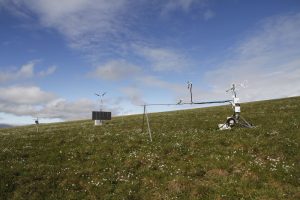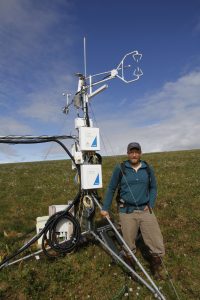US-ICt: Imnavait Creek Watershed Tussock Tundra
- Overview
- Windroses
- Data Citation
- Data Use Log
- Image Gallery
- Remote Sensing Data
- MODIS
- PhenoCam
- GeoNEX
- Publications
- BADM
| Tower_team: | |
| PI: | Eugenie Euskirchen seeuskirchen@alaska.edu - University of Alaska Fairbanks |
| PI: | Syndonia Bret-Harte msbretharte@alaska.edu - University of Alaska Fairbanks |
| FluxContact: | Colin Edgar cedgar3@alaska.edu - University of Alaska Fairbanks |
| Lat, Long: | 68.6063, -149.3041 |
| Elevation(m): | 930 |
| Network Affiliations: | AmeriFlux, Phenocam |
| Vegetation IGBP: | OSH (Open Shrublands: Lands with woody vegetation less than 2 meters tall and with shrub canopy cover between 10-60%. The shrub foliage can be either evergreen or deciduous.) |
| Climate Koeppen: | ET (Tundra) |
| Mean Annual Temp (°C): | -7.4 |
| Mean Annual Precip. (mm): | 318 |
| Flux Species Measured: | CO2 |
| Years Data Collected: | 2007 - Present |
| Years Data Available: | AmeriFlux BASE 2007 - 2025 Data Citation AmeriFlux FLUXNET 2007 - 2023 Data Citation |
| Data Use Policy: | AmeriFlux CC-BY-4.0 Policy1 |
| Description: | |
| URL: | http://aon.iab.uaf.edu/imnavait |
| Research Topics: | |
| Acknowledgment: | — |
- This site’s data can also be used under the more restrictive AmeriFlux Legacy Policy.
The AmeriFlux Legacy Policy must be followed if this site’s data are combined with data from sites that require the AmeriFlux Legacy Policy.

Copyright preference: Open use
US-ICt: Imnavait Creek Watershed Tussock Tundra
- Overview
- Windroses
- Data Citation
- Data Use Log
- Image Gallery
- Remote Sensing Data
- MODIS
- PhenoCam
- GeoNEX
- Publications
- BADM
Use the information below for citation of this site. See the Data Policy page for more details.
DOI(s) for citing US-ICt data
Data Use Policy: AmeriFlux CC-BY-4.0 License
This site’s data can also be used under the more restrictive AmeriFlux Legacy Policy.
The AmeriFlux Legacy Policy must be followed if US-ICt data are combined with data from sites that require the AmeriFlux Legacy Policy.
- AmeriFlux BASE: https://doi.org/10.17190/AMF/1246131
Citation: Eugenie Euskirchen, Gaius Shaver, Syndonia Bret-Harte (2025), AmeriFlux BASE US-ICt Imnavait Creek Watershed Tussock Tundra, Ver. 9-5, AmeriFlux AMP, (Dataset). https://doi.org/10.17190/AMF/1246131 - AmeriFlux FLUXNET: https://doi.org/10.17190/AMF/1881583
Citation: Eugenie Euskirchen, Gaius Shaver, Syndonia Bret-Harte (2024), AmeriFlux FLUXNET-1F US-ICt Imnavait Creek Watershed Tussock Tundra, Ver. 4-6, AmeriFlux AMP, (Dataset). https://doi.org/10.17190/AMF/1881583
Find global FLUXNET datasets, like FLUXNET2015 and FLUXNET-CH4, and their citation information at fluxnet.org.
To cite BADM when downloaded on their own, use the publications below for citing site characterization. When using BADM that are downloaded with AmeriFlux BASE and AmeriFlux FLUXNET products, use the DOI citation for the associated data product.
Publication(s) for citing site characterization
- —
Acknowledgments
- —
Resources
- AmeriFlux Logos & Acknowledgments
US-ICt: Imnavait Creek Watershed Tussock Tundra
- Overview
- Windroses
- Data Citation
- Data Use Log
- Image Gallery
- Remote Sensing Data
- MODIS
- PhenoCam
- GeoNEX
- Publications
- BADM
This page displays the list of downloads of data for the site {{siteId}}.
Note: Results are the number of downloads to distinct data users. The Download Count column indicates the number of times the data user downloaded the data. The Version column refers to the version of the data product for the site that was downloaded by the data user.
| Date | Name | Data Product | Vers. | Intended Use | Intended Use Description | Download Count |
|---|---|---|---|---|---|---|
| {{dlObject.timeStamp}} | {{dlObject.displayName}} | {{displayProduct(dlObject.dataProduct)}} | {{dlObject.version}} | {{dlObject.intendedUse}} | {{dlObject.comment}} | {{dlObject.downloadCounter}} |
Showing {{startItem + 1}} to {{(startItem + items) > filtered.length ? filtered.length : (startItem + items)}} of {{filtered.length}} results
Showing 0 to 0 of 0 results
Not Found
Uh Oh. Something is missing. Try double checking the URL and try again.
US-ICt: Imnavait Creek Watershed Tussock Tundra
- Overview
- Windroses
- Data Citation
- Data Use Log
- Image Gallery
- Remote Sensing Data
- MODIS
- PhenoCam
- GeoNEX
- Publications
- BADM
| AmeriFlux Images | Add Image |
 US-ICt
US-ICt Colin Edgar at US-ICt
Keywords: —
Location: United States
View in Original Size
To download, right-click photo (Mac: control-click) and choose Save Image As
 US-ICt
US-ICt Flux tower
Keywords: —
Location: Alaska, United States
View in Original Size
To download, right-click photo (Mac: control-click) and choose Save Image As
US-ICt: Imnavait Creek Watershed Tussock Tundra
- Overview
- Windroses
- Data Citation
- Data Use Log
- Image Gallery
- Remote Sensing Data
- MODIS
- PhenoCam
- GeoNEX
- Publications
- BADM
| AmeriFlux Publications | Add Publication |
| Year | Publication |
|---|---|
| 2022 | Oehri, J., Schaepman-Strub, G., Kim, J., Grysko, R., Kropp, H., Grünberg, I., Zemlianskii, V., Sonnentag, O., Euskirchen, E. S., Reji Chacko, M., Muscari, G., Blanken, P. D., Dean, J. F., di Sarra, A., Harding, R. J., Sobota, I., Kutzbach, L., Plekhanova, E., Riihelä, A., Boike, J., Miller, N. B., Beringer, J., López-Blanco, E., Stoy, P. C., Sullivan, R. C., Kejna, M., Parmentier, F. W., Gamon, J. A., Mastepanov, M., Wille, C., Jackowicz-Korczynski, M., Karger, D. N., Quinton, W. L., Putkonen, J., van As, D., Christensen, T. R., Hakuba, M. Z., Stone, R. S., Metzger, S., Vandecrux, B., Frost, G. V., Wild, M., Hansen, B., Meloni, D., Domine, F., te Beest, M., Sachs, T., Kalhori, A., Rocha, A. V., Williamson, S. N., Morris, S., Atchley, A. L., Essery, R., Runkle, B. R., Holl, D., Riihimaki, L. D., Iwata, H., Schuur, E. A., Cox, C. J., Grachev, A. A., McFadden, J. P., Fausto, R. S., Göckede, M., Ueyama, M., Pirk, N., de Boer, G., Bret-Harte, M. S., Leppäranta, M., Steffen, K., Friborg, T., Ohmura, A., Edgar, C. W., Olofsson, J., Chambers, S. D. (2022) Vegetation Type Is An Important Predictor Of The Arctic Summer Land Surface Energy Budget, Nature Communications, 13(1), . https://doi.org/10.1038/s41467-022-34049-3 |
| 2017 | Euskirchen, E. S., Bret-Harte, M. S., Shaver, G. R., Edgar, C. W., Romanovsky, V. E. (2017) Long-Term Release Of Carbon Dioxide From Arctic Tundra Ecosystems In Alaska, Ecosystems, 20(5), 960-974. https://doi.org/http://dx.doi.org/10.1007/s10021-016-0085-9 |
| 2012 | Euskirchen, E. S., Bret-Harte, M. S., Scott, G. J., Edgar, C., Shaver, G. R. (2012) Seasonal Patterns Of Carbon Dioxide And Water Fluxes In Three Representative Tundra Ecosystems In Northern Alaska, Ecosphere, 3(1), 1-19. https://doi.org/10.1890/ES11-00202.1 |
| 2012 | Kade, A., Bret-Harte, M. S., Euskirchen, E. S., Edgar, C., Fulweber, R. A. (2012) Upscaling Of CO2 Fluxes From Heterogeneous Tundra Plant Communities In Arctic Alaska, Journal Of Geophysical Research: Biogeosciences, 117(G4), n/a-n/a. https://doi.org/10.1029/2012JG002065 |
US-ICt: Imnavait Creek Watershed Tussock Tundra
- Overview
- Windroses
- Data Citation
- Data Use Log
- Image Gallery
- Remote Sensing Data
- MODIS
- PhenoCam
- GeoNEX
- Publications
- BADM
BADM for This Site
Access the Biological, Ancillary, Disturbance and Metadata (BADM) information and data for this site.
BADM contain information for many uses, such as characterizing a site’s vegetation and soil, describing disturbance history, and defining instrumentation for flux processing. They complement the flux/met data.
- Download BADM for this site*
- View Site General Info for this site (Overview tab)*
- Use Online Editor to update Site General Info or DOI Authorship
- Update information about submitted data (Variable Information tool)
- More BADM resources
* Online updates are shown on the Overview tab real time. However, downloaded BADM files will not reflect those updates until they have been reviewed for QA/QC.
US-ICt: Imnavait Creek Watershed Tussock Tundra
- Overview
- Windroses
- Data Citation
- Data Use Log
- Image Gallery
- Remote Sensing Data
- MODIS
- PhenoCam
- GeoNEX
- Publications
- BADM
Wind Roses
Wind Speed (m/s)
- Wind Speed Scale: Per Site
- Wind Direction Scale (%): Per Site
- Wind Speed Scale: Non-Linear
- Wind Direction Scale (%): AmeriFlux




